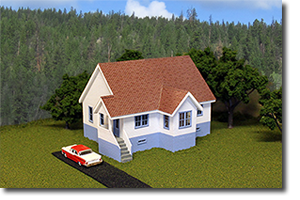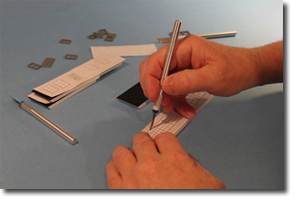Please allow Pop-ups from scalemodelbuildings.co in order to fully utilize our website

About ScaleModelPlans
ScaleModelPlans is the culmination and combination of several years involvement in architectural design, model railroading, and woodworking. It is a family business where similar interests overlap, and dissimilar interests augment, (I'd rather build something than reconcile a bank statement, but fortunately someone around here likes that sort of thing). It is also a way of commemorating and immortalizing the architecture of our past. As model railroaders, I think that is a significant part of what we do, whether consciously or not, to take a moment from our past and preserve it.
I spent most of my childhood in a 1:1 scale version of the house in the picture. Built in the 1920's it had a lot of interesting features not found in most homes today, but one of the drawbacks was the low ceiling in the basement, making it unsuitable for additional living space. Fortunately, a seven foot ceiling was more than adequate for a model railroad layout. That's where it all started.
In this day and age real estate and lumber prices continue to rise, but this is of little consequence to me, because as long as I can afford another sheet of plywood and some hobby supplies I can continue to design and build. I hope that you will too, and I thank you for visiting this site. I would also like to publicly thank those who have suggested interesting projects for our catalog, and the several "foot soldiers" who have helped us in travelling to the various sites for the photographing, measuring, and research involved in creating these plans.
Tom Carson

Visit our News Page for monthly discounts on select model railroad structure plan packages.
Up to 15% off!
Where our Customers Come From
( Dots represent cities):
Dots represent cities):
Any place in the world that you can find a railroad it seems you will also find model railroaders and model builders. Languages, cultures, and geography may be very different, but a common interest that seems to span all of our differences is an interest in model building. The map below shows the location of the cities of some of our customers:

My Thoughts on Scratch Building (The Zen of Model-making)
Most of the plans on this site have some historical significance and represent a time from the past. One of the reasons for this is that a historical building will fit any era of model railroad layout. The other reason is that, as I mentioned earlier, it is my attempt to preserve a bit of history. The dimensions and features are preserved as accurately as possible through either historical documents, direct measurements by myself or my various "foot-soldiers" throughout North America, or a combination of these sources. I also attempt to find interesting 'generic' examples, or buildings styles and plans that were common and used in multiple locations, such as the CNoR 3rd Class Depot, which was used extensively across Canada and into Minnesota. This makes it easier for those seeking more significant historical accuracy on an era/location-specific model railroad layout.
Scratch building and scale Modeling is an area where most people are their own worst critics. There was a story of a Michelangelo statue that was never intended to be seen from the rear, but was as intricately detailed as the front, even though no one should have ever had the opportunity to lay eyes on it. But Michelangelo knew, and that was enough. I have known builders like that, myself included, that could not sleep at night knowing that something was not right, even though it had no structural relevance and was hidden behind drywall. I think that it is this trait of human nature that causes us to self-criticize
and repeat our efforts until we reach perfection. Unfortunately, this sometimes increases our frustration level as well. What we have to keep in mind is that in most cases, we are the only ones aware of the imperfections in our projects. It is a psychological struggle that we have to deal with, and accept that there is nothing wrong with displaying a scale model structure that is less than 100 percent perfect. That's what trees and shrubs are for. Worst case scenario, you can place your first attempt toward the back of your layout,
and start again. That's the beauty of scratch building from printable plans.
enough. I have known builders like that, myself included, that could not sleep at night knowing that something was not right, even though it had no structural relevance and was hidden behind drywall. I think that it is this trait of human nature that causes us to self-criticize
and repeat our efforts until we reach perfection. Unfortunately, this sometimes increases our frustration level as well. What we have to keep in mind is that in most cases, we are the only ones aware of the imperfections in our projects. It is a psychological struggle that we have to deal with, and accept that there is nothing wrong with displaying a scale model structure that is less than 100 percent perfect. That's what trees and shrubs are for. Worst case scenario, you can place your first attempt toward the back of your layout,
and start again. That's the beauty of scratch building from printable plans.
I have included a pictorial construction guide with each plan and will continue to add tutorials to this site, but these are guides and suggestions only. There is often more than one way to accomplish the same task and some may work better for you than the method I have suggested. As a modeler you have probably already discovered various tricks, and will continue to build your library of skills. If you come up with a new or unique method and wish to share, let us know and it could become a tutorial for others to learn from. Try a few different versions of each project. I usually start out with the cardstock model to help visualize the overall shape, then build the next copy in foam board or scaled lumber, or both.
Wherever our skill level happens to be at the moment, practice makes perfect. Practicing is the fun part and the skills improve. Don't worry too much about mistakes because we learn from them, and material is relatively cheap, (compared to a 1:1 scale house). You don't have to worry about building codes, and you are the construction superintendent, so your rules are the only rules.
Happy modeling.
All Structure images on this site are photos of actual scale models
Scale model plans
for HO Scale, N Scale, OO and O Scale model railroad buildings and structures. Create realistic,
inexpensive scale model buildings for your model railroad layout, diorama, or toy train set. Build to accurate scale with Computer Aided Design miniature plans or simply cut out the traceable templates. As an added limited time offer, you can print out color patterns to card stock to create paper models of buildings and structures. If 'kit-bashing' is more your style, try customizing, or combining patterns. Use up your leftover model building supplies to create a unique scale model structure. View our on-line catalog of HO Scale , N Scale, OO and O Scale plans to get started on your next building in scale project. Beginners Welcome!
Contact Us © 2023 T. Carson Legal












